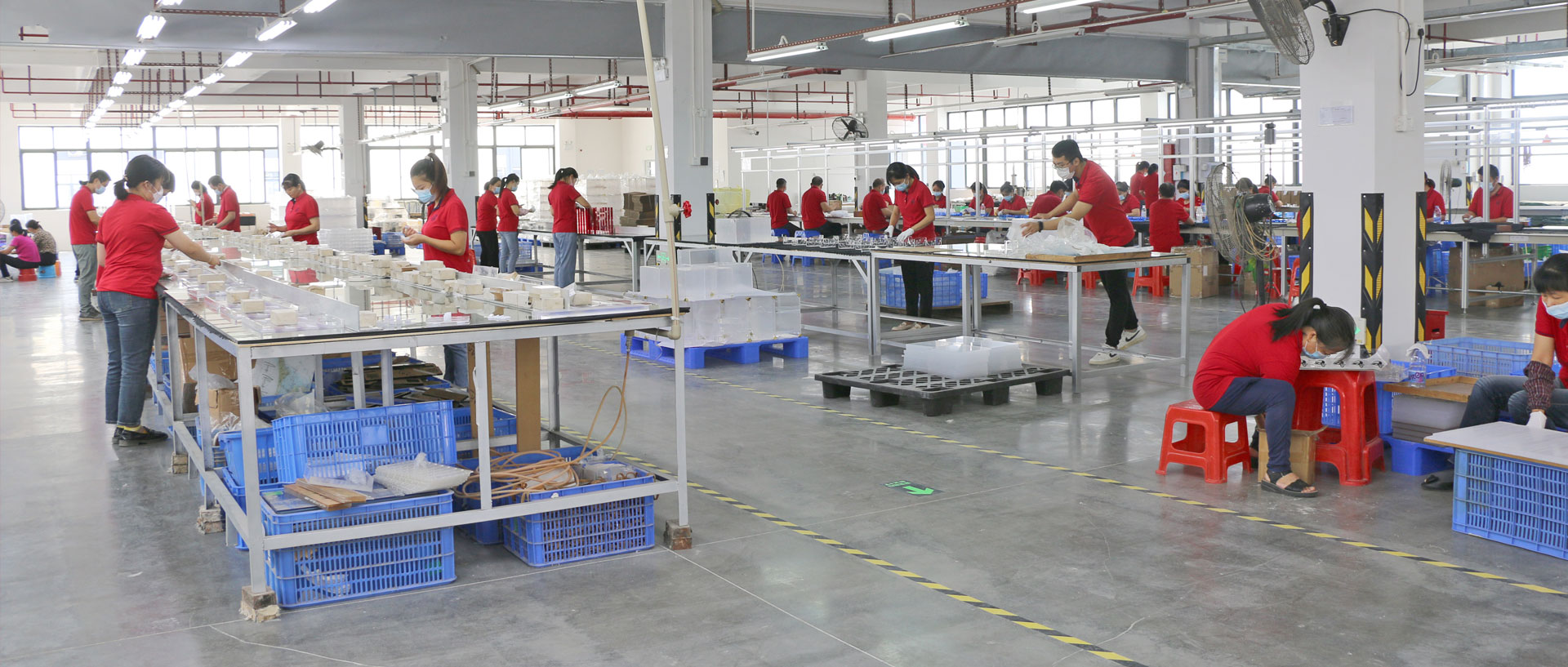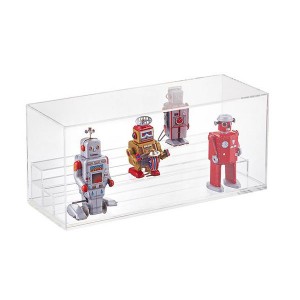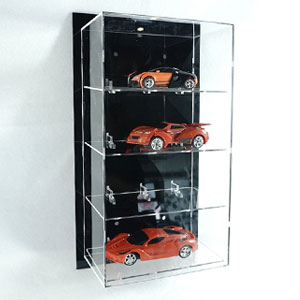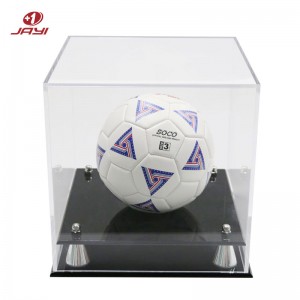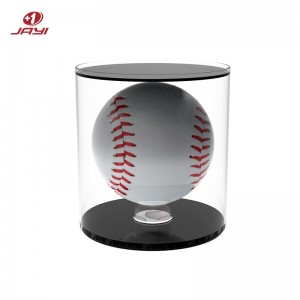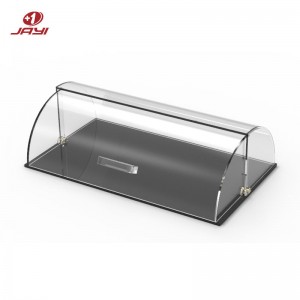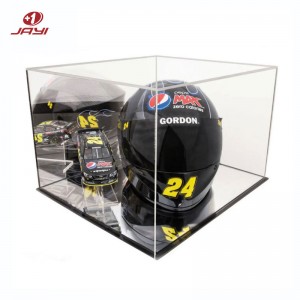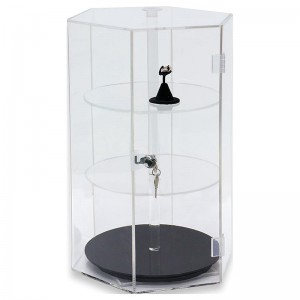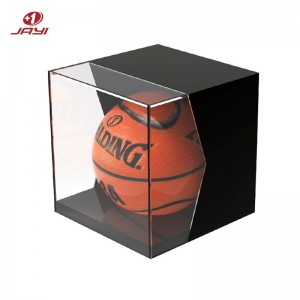
Acrylic display cases have become a staple in retail stores, museums, and even homes, thanks to their transparency, durability, and versatility.
When businesses order these acrylic cases in bulk, they expect consistent quality to showcase their products effectively.
However, bulk production often comes with unique challenges that can lead to quality issues.
In this blog, we’ll explore the most common problems with bulk acrylic display cases—from deformation to discoloration—and share practical solutions to avoid them.
By understanding these issues and how reputable factories address them, you can make informed decisions and build trust with your manufacturing partner.
1. Deformation: Why Acrylic Display Cases Lose Their Shape and How to Prevent It
Deformation is one of the most frustrating issues with bulk acrylic display cases. Imagine receiving a shipment of cases only to find that their edges are warped or their surfaces are bowed—rendering them useless for displaying products. This problem typically stems from two key factors: poor material selection and inadequate cooling during production.
Acrylic sheets come in different grades, and using low-quality or thin acrylic for bulk orders is a recipe for deformation. Low-grade acrylic has lower heat resistance, meaning it can soften and warp when exposed to even mild temperatures (such as those in a retail store with bright lighting). Additionally, if the acrylic sheets are too thin for the case’s size, they lack the structural support to hold their shape, especially when holding heavier products.
The production process also plays a critical role. During molding or cutting, acrylic is heated to shape it. If the cooling process is rushed—common in factories trying to meet tight bulk deadlines—the material doesn’t set properly. Over time, this leads to warping, especially when the cases are stored in areas with temperature fluctuations.
How to Avoid Deformation:
Choose High-Grade Acrylic: Opt for acrylic sheets with a minimum thickness of 3mm for small cases and 5mm for larger ones. High-grade acrylic (such as cast acrylic) has better heat resistance and structural stability than extruded acrylic, making it ideal for bulk orders.
Ensure Proper Cooling: Reputable factories will use controlled cooling systems after molding or cutting. Ask your manufacturer about their cooling process—they should be able to provide details on temperature control and cooling time.
Store Cases Correctly: After receiving the bulk shipment, store the cases in a cool, dry area, away from direct sunlight and heat sources. Avoid stacking heavy items on top of the cases, as this can cause pressure-related deformation.
2. Cracking: The Hidden Risk in Bulk Acrylic Display Cases and Solutions
Cracking is another common issue that can occur in bulk acrylic display cases, often appearing weeks or even months after delivery. This problem is usually caused by stress points in the acrylic, which can develop during production or handling.
During bulk production, if the acrylic sheets are cut or drilled incorrectly, it can create small, invisible fractures along the edges. These fractures weaken the material, and over time, exposure to temperature changes or minor impacts can cause them to spread into larger cracks. Another cause of cracking is improper bonding. When assembling the plexiglass cases, if the adhesive used is too strong or applied unevenly, it can create internal stress in the acrylic, leading to cracks.
Handling during shipping is also a factor. Bulk shipments of acrylic cases are often stacked to save space, but if the stacking is done without proper padding, the weight of the top cases can put pressure on the bottom ones, causing cracks along the edges or corners.
How to Avoid Cracking:
Precision Cutting and Drilling: Look for factories that use CNC (Computer Numerical Control) machines for cutting and drilling. CNC machines ensure precise, clean cuts that minimize stress points in the acrylic. Ask your manufacturer to provide samples of their cut edges to check for smoothness.
Use the Right Adhesive: The adhesive used to assemble acrylic cases should be specifically designed for acrylic (such as methyl methacrylate adhesive). Avoid factories that use generic glues, as these can cause stress and discoloration. Additionally, the adhesive should be applied in thin, even layers to prevent excess pressure.
Proper Packaging for Shipping: When ordering in bulk, ensure that the factory uses individual padding for each case (such as foam or bubble wrap) and that the shipping boxes are sturdy enough to withstand stacking. Ask for details on their packaging process—reputable factories will have a standardized packaging method to protect bulk shipments.
3. Scratching: Keeping Acrylic Display Cases Clear and Scratch-Free
Acrylic is known for its transparency, but it’s also prone to scratching—especially during bulk production and shipping. Scratches can make the cases look unprofessional and reduce their ability to showcase products effectively. Common causes of scratching include poor handling during production, low-quality cleaning materials, and inadequate packaging.
During bulk production, if the acrylic sheets are not stored properly (e.g., stacked without protective films), they can rub against each other, causing surface scratches. Additionally, if the factory uses rough cleaning cloths or harsh cleaning chemicals to wipe down the cases before shipping, it can scratch the acrylic surface.
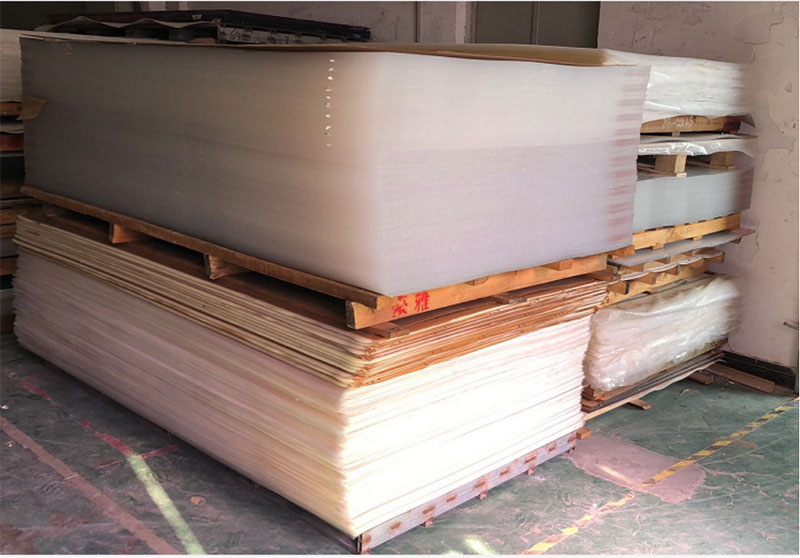
Shipping is another major culprit. When acrylic cases are packed tightly together without padding, they can shift during transit, leading to scratches from friction between the cases. Even small particles (such as dust or debris) trapped between the cases can cause scratches when the boxes are moved.
How to Avoid Scratching:
Protective Films During Production: Reputable factories will leave the protective film on the acrylic sheets until the final assembly stage. This film prevents scratches during cutting, drilling, and handling. Ask your manufacturer to confirm that they use protective films and that they only remove them before shipping.
Gentle Cleaning Methods: The factory should use soft, lint-free cloths (such as microfiber cloths) and mild cleaning solutions (such as a 50/50 mix of water and isopropyl alcohol) to clean the cases. Avoid factories that use abrasive cleaners or rough sponges.
Adequate Padding in Shipping: Each case should be wrapped in a protective layer (such as bubble wrap or foam) and placed in a separate compartment within the shipping box. This prevents the cases from rubbing against each other and reduces the risk of scratches.
4. Acrylic Display Cases Size Deviation: Ensuring Consistency in Bulk Orders
When ordering acrylic display cases in bulk, consistency in size is crucial—especially if you’re using the cases to fit specific products or store fixtures. Size deviation can occur due to inaccurate measurements during production or thermal expansion of the acrylic.
Inaccurate measurements are often the result of outdated or poorly calibrated equipment. If the factory uses manual measuring tools (such as rulers or tape measures) instead of digital tools (such as laser measuring devices), it can lead to small but consistent errors in size. Over the course of a bulk order, these errors can add up, resulting in cases that are too small or too large for their intended use.
Thermal expansion is another factor. Acrylic expands and contracts with temperature changes, and if the factory produces the cases in an environment with fluctuating temperatures, the size of the cases can vary. For example, if the acrylic is cut in a hot workshop, it may contract when cooled, leading to cases that are smaller than the intended size.
How to Avoid Size Deviation:
Use Digital Measuring Tools: Choose factories that use digital measuring devices (such as laser calipers or CNC machines with built-in measurement systems) to ensure accurate size control. Ask your manufacturer to provide a tolerance range for the cases—reputable factories will typically offer a tolerance of ±0.5mm for small cases and ±1mm for larger ones.
Control Production Environment: The factory should maintain a consistent temperature and humidity level in its production facility. This prevents thermal expansion and contraction of the acrylic during cutting and assembly. Ask about their facility’s climate control systems—they should be able to provide details on temperature and humidity ranges.
Sample Testing Before Bulk Production: Before placing a large bulk order, request a sample case from the factory. Measure the sample to ensure it meets your size requirements, and test it with your products to confirm a proper fit. This allows you to catch any size issues before the bulk production begins.
5. Discoloration: Keeping Acrylic Display Cases Clear Over Time
Discoloration is a common issue that affects the appearance of bulk acrylic display cases, turning them yellow or cloudy over time. This problem is primarily caused by UV exposure and low-quality acrylic material.
Low-grade acrylic contains fewer UV stabilizers, which protect the material from the sun’s harmful rays. When exposed to direct sunlight or fluorescent lighting (common in retail stores), the acrylic can break down, leading to yellowing. Additionally, if the factory uses recycled acrylic without proper purification, it can contain impurities that cause discoloration.
Another cause of discoloration is improper storage after production. If the cases are stored in a damp area, mold or mildew can grow on the surface, leading to cloudy spots. Harsh cleaning chemicals can also cause discoloration, as they can break down the acrylic’s surface layer.
How to Avoid Discoloration:
Choose UV-Resistant Acrylic: Opt for acrylic sheets that are infused with UV stabilizers. These sheets are designed to resist yellowing and discoloration, even when exposed to sunlight for long periods. Ask your manufacturer to confirm that their acrylic has UV protection—they should be able to provide specifications on the UV resistance rating.
Avoid Recycled Acrylic for Display Cases: While recycled acrylic is eco-friendly, it’s not ideal for display cases, as it often contains impurities that cause discoloration. Stick to virgin acrylic for bulk orders to ensure a clear, long-lasting finish.
Proper Storage and Cleaning: Store the cases in a dry, well-ventilated area away from direct sunlight. Use mild cleaning solutions (such as water and mild soap) to clean the cases, and avoid harsh chemicals like ammonia or bleach.
6. Acrylic Display Case Poor Edge Finishing: The Overlooked Quality Issue
Edge finishing is often overlooked, but it’s a key indicator of the quality of bulk acrylic display cases. Rough or uneven edges not only look unprofessional but can also pose a safety risk (e.g., sharp edges can cut hands during handling). Poor edge finishing is typically caused by low-quality cutting tools or rushed production.
If the factory uses dull blades or saws to cut the acrylic sheets, it can leave rough, jagged edges. Additionally, if the edges are not polished properly after cutting, they can appear cloudy or uneven. In bulk production, factories may skip the polishing step to save time, leading to subpar edge quality.
How to Avoid Poor Edge Finishing:
Polished Edges as Standard: Look for factories that offer polished edges as a standard feature for bulk orders. Polished edges not only improve the appearance of the cases but also smooth out any sharp points. Ask your manufacturer to provide samples of their polished edges to check for smoothness and clarity.
Use High-Quality Cutting Tools: Factories that use sharp, high-quality blades (such as diamond-tipped blades) for cutting acrylic will produce cleaner edges. Additionally, CNC machines with edge-polishing attachments can ensure consistent edge quality across bulk orders.
Inspect Samples for Edge Quality: Before placing a bulk order, request a sample case and inspect the edges closely. Look for smoothness, clarity, and absence of sharp points. If the sample’s edges are subpar, consider choosing a different manufacturer.
Building Trust with Your Acrylic Display Case Factory
Understanding the common quality issues in bulk acrylic display cases and how to solve them is key to building trust with your factory. A reputable factory will be transparent about its production processes, use high-quality materials, and take steps to prevent quality issues. Here are some tips to ensure you’re working with a trustworthy partner:
Ask for Certifications: Look for factories that have certifications for acrylic production (such as ISO 9001). These certifications indicate that the factory follows strict quality control standards.
Request Production Process Details: A trustworthy factory will be happy to share details about their material selection, cutting and assembly processes, cooling systems, and packaging methods. If a factory is hesitant to provide this information, it may be a red flag.
Check Customer Reviews and References: Before placing a bulk order, read customer reviews of the factory and ask for references. Contact past customers to ask about their experience with the factory’s quality and service.
Conduct On-Site Inspections (If Possible): If you’re placing a large bulk order, consider visiting the factory in person to inspect their facilities and production processes. This allows you to see firsthand how the cases are made and ensure that the factory meets your quality standards.
Jayiacrylic: Your Leading Custom Acrylic Display Case Factory
Jayi Acrylic is a professional custom acrylic display case factory based in China, dedicated to crafting products that excel in both commercial showcasing and personal collection scenarios. Our acrylic display cases are thoughtfully designed to meet diverse needs, delivering exceptional performance to highlight products or treasures effectively.
Certified with ISO9001 and SEDEX, we adhere to strict quality control and responsible production standards, ensuring every case meets superior quality benchmarks. With over 20 years of experience collaborating with renowned brands, we deeply grasp the balance between functionality, durability, and aesthetic appeal—key elements to satisfy both commercial clients and individual consumers. Whether for retail displays or personal collections, Jayi Acrylic’s products stand out as reliable, visually appealing solutions.
Conclusion
Bulk acrylic display cases are a valuable investment for businesses, but they come with unique quality challenges.
By understanding the common issues—deformation, cracking, scratching, size deviation, discoloration, and poor edge finishing—and how to avoid them, you can ensure that your bulk order meets your expectations.
Working with a reputable factory that uses high-quality materials, precise equipment, and strict quality control processes is key to avoiding these issues and building long-term trust.
With the right partner and proactive measures, you can get bulk acrylic display cases that are durable, transparent, and consistent—perfect for showcasing your products.
FAQs About Bulk Acrylic Display Cases

How Can I Confirm if a Factory Uses High-Grade Acrylic for Bulk Orders?
To verify a factory’s acrylic quality, start by asking for material specifications—reputable factories will share details like whether they use cast acrylic (ideal for display cases) or extruded acrylic, and the sheet thickness (3mm for small cases, 5mm for larger ones).
Request a sample of the acrylic sheet or a finished case; high-grade acrylic will have consistent transparency, no visible bubbles, and smooth edges.
You can also ask for certifications related to acrylic quality, such as compliance with industry standards for UV resistance or structural stability. Additionally, inquire if they use virgin acrylic (not recycled) to avoid discoloration issues—recycled acrylic often has impurities that harm long-term appearance.
What Should I Do if My Bulk Acrylic Cases Arrive with Minor Scratches?
Minor scratches on bulk acrylic cases can often be repaired with simple at-home methods.
First, clean the scratched area with a mild solution of water and isopropyl alcohol to remove dust.
For light scratches, use a microfiber cloth with a small amount of acrylic polish (available at hardware stores) and rub gently in circular motions until the scratch fades.
For slightly deeper scratches, use a fine-grit sandpaper (1000-grit or higher) to sand the area lightly, then follow with polish to restore shine.
If scratches are severe or widespread, contact the factory—reputable manufacturers will offer a replacement or refund for defective cases, especially if the issue stems from poor packaging or production handling.
How Do I Ensure Consistent Size Across All Acrylic Display Cases in a Bulk Order?
To guarantee size consistency, start by requesting a pre-production sample—measure it against your product dimensions to confirm it fits.
Ask the factory about their measurement tools; they should use digital devices like laser calipers or CNC machines (which have built-in precision controls) instead of manual tools.
Inquire about their tolerance range—most reliable factories offer ±0.5mm for small cases and ±1mm for larger ones.
Also, ask if their production facility has climate control: consistent temperature and humidity prevent acrylic from expanding or contracting during cutting, which causes size deviation.
Finally, include size requirements in your contract, so the factory is accountable for any deviations.
Will Bulk Acrylic Display Cases Yellow over Time, And How Can I Prevent It?
Bulk acrylic cases may yellow over time if they are made of low-grade acrylic without UV protection, but this is avoidable.
First, choose factories that use UV-resistant acrylic—ask for specifications on UV stabilizer levels (look for acrylic rated to resist yellowing for 5+ years).
Avoid recycled acrylic, as it often lacks UV additives and has impurities that speed up discoloration.
Once you receive the cases, store and use them properly: keep them out of direct sunlight (use window film in retail spaces if needed) and clean them with mild solutions (water + mild soap) instead of harsh chemicals like ammonia.
Following these steps will keep cases clear for years.
What Should I Do if a Factory Refuses to Share Production Process Details?
If a factory declines to share production details (e.g., cooling methods, cutting tools, packaging processes), it’s a major red flag—transparency is key to trust.
First, politely explain why you need the information (e.g., to ensure they prevent deformation or cracking) and ask again—some factories may need clarification on your needs. If they still refuse, consider looking for another manufacturer.
Reputable factories will happily share details like whether they use CNC machines for cutting, controlled cooling systems, or individual padding for shipping.
You can also check their reviews or ask for references from past clients—if other businesses have had positive experiences with their transparency, it may ease concerns, but refusal to share critical details usually indicates poor quality control.
You Might Also Like Custom Acrylic Display Cases
Post time: Sep-05-2025

